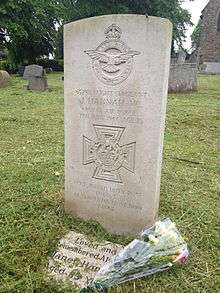John Hannah (VC)
| John Hannah | |
|---|---|
 | |
| Born |
27 November 1921 Paisley, Scotland |
| Died |
7 June 1947 (aged 25) Markfield, Leicestershire |
| Buried at | St Jame's Churchyard, Birstall, Leicestershire |
| Allegiance |
|
| Service/branch |
|
| Years of service | 1939 - 1942 |
| Rank | Flight Sergeant |
| Service number | 652918 |
| Unit | No. 83 Squadron |
| Battles/wars | World War II |
| Awards | Victoria Cross |
John Hannah VC (27 November 1921 – 7 June 1947) was a Scottish recipient of the Victoria Cross, the highest and most prestigious award for gallantry in the face of the enemy that can be awarded to British and Commonwealth forces.
Early life
Born in Paisley and educated at Bankhead Primary School and Victoria Drive Secondary School, Glasgow, Hannah joined the Royal Air Force in 1939. After training as a wireless operator was promoted to sergeant in 1940. He was attached to No. 83 Squadron, flying Handley Page Hampden bombers as a wireless operator/gunner. He was 18 years old, making him the youngest recipient of the Victoria Cross for aerial operations (and the youngest for World War II), and a sergeant in No. 83 Squadron, Royal Air Force during the Second World War.
Action

On 15 September 1940 over Antwerp, Belgium, after a successful attack on German barges, the Handley Page Hampden bomber (serial P1355) in which Sergeant Hannah was wireless operator/air gunner, was subjected to intense anti-aircraft fire, starting a fire which spread quickly. The rear gunner and navigator had to bail out and Sergeant Hannah could have acted likewise, but instead he remained to fight the fire, first with two extinguishers and then with his bare hands. He sustained terrible injuries, but succeeded in putting out the fire and the pilot was able to bring the almost wrecked aircraft back safely.
Victoria Cross citation
The announcement and accompanying citation for the decoration was published in supplement to the London Gazette on 1 October 1940, reading[1]
'The KING has been graciously pleased to confer the VICTORIA CROSS on the undermentioned officer in recognition of most conspicuous bravery :-652918 Sergeant John Hannah :-
On the night of 15th September, 1940, Sergeant Hannah was the wireless operator/air gunner in an aircraft engaged in a successful attack on an enemy barge concentration at Antwerp. It was then subjected to intense anti-aircraft fire and received a direct hit from a projectile of an explosive and incendiary nature, which apparently burst inside the bomb compartment.
A fire started which quickly enveloped the wireless operators and rear gunners cockpits, and as both the port and starboard petrol tanks had been pierced, there was grave risk of the fire spreading. Sergeant Hannah forced his way through to obtain two extinguishers and discovered that the rear gunner had had to leave the aircraft. He could have acted likewise, through the bottom escape hatch or forward through the navigators hatch, but remained and fought the fire for ten minutes with the extinguishers, beating the flames with his log book when these were empty.
During this time thousands of rounds of ammunition exploded in all directions and he was almost blinded by the intense heat and fumes, but had the presence of mind to obtain relief by turning on his oxygen supply. Air admitted through the large holes caused by the projectile made the bomb compartment an inferno and all the aluminium sheet metal on the floor of this airmans cockpit was melted away, leaving only the cross bearers.
Working under these conditions, which caused burns to his face and eyes, Sergeant Hannah succeeded in extinguishing the fire. He then crawled forward, ascertained that the navigator had left the aircraft, and passed the latter's log and maps to the pilot. This airman displayed courage, coolness and devotion to duty of the highest order and by his action in remaining and successfully extinguishing the fire under conditions of the greatest danger and difficulty, enabled the pilot to bring the aircraft to its base.[2]
Later life and death

He contracted tuberculosis only a year later in mid-late 1941, brought on no doubt by his weakened condition following the severe burns he sustained during his VC action. This necessitated his eventual discharge, with full disability pension, from the RAF in December 1942. However, unable thereafter to take up a full-time job, he initially took a job as a taxi driver (using a car his aunt had lent him) but due to increasing ill health he returned the car in 1943. He then found it increasingly difficult to support his wife and three small daughters, and his health ultimately gave out. He died on 7 June 1947 at Markfield Sanatorium in Leicester, where he had been lying for four months. He is buried in the churchyard of St James the Great Church, Church Hill, Birstall, north Leicester. His wife, Janet Hannah, is also interred there with her husband. An inscription to her reads 'Loved and remembered always Janet Hannah Aged 83 years'. It is ironic that Janet died also as a result of burns, having fallen in her garden and unable to move, she suffered horrendous sunburn and later died.
His headstone is inscribed:-
Courageous Duty Done In Love, He Serves His Pilot Now Above.
The medal
His Victoria Cross is displayed at the Royal Air Force Museum, Hendon, London.
References
- ↑ http://www.bomber-command.info/vchannah.htm
- ↑ The London Gazette: no. 34958. p. 5788. 1 October 1940. Retrieved 18 June 2015.
- British VCs of World War 2 (John Laffin, 1997)
- Monuments to Courage (David Harvey, 1999)
- The Register of the Victoria Cross (This England, 1997)
- Scotland's Forgotten Valour (Graham Ross, 1995)
External links
- Sergeant J. Hannah in The Art of War exhibition at the UK National Archives
- Location of grave and VC medal (Leicestershire)